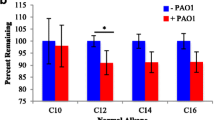Abstract
Bacterial cells modify their gene expression profiles throughout different stages of growth and in response to environmental cues. Analyses of gene expression across conditions reveal both conserved and condition-specific gene responses of bacteria to adapt to these dynamic conditions. In this chapter, we present a guide to pneumococcal RNA extraction for use in the NanoString nCounter platform. The nCounter is a highly effective method to measure gene expression of bacteria not only in a planktonic mode of growth but also in the presence of host cells where the RNA of interest represents only a small portion of the total material.
Access this chapter
Tax calculation will be finalised at checkout
Purchases are for personal use only
Similar content being viewed by others
Notes
- 1.
In our initial RNA extractions from murine tissue, we employed RNAlater to preserve RNA (Life Technologies) and observed very low yields. Our yields improved with flash-freezing the tissue immediately after removal from the animal.
- 2.
We lyse cells at room temperature, and have found that we achieved high quality RNA (as measured by an Agilent Bioanalyzer). However, many laboratories maintain material on ice while extracting RNA. We elected room temperature, to ensure full activity of the cell wall lytic enzymes.
References
Ogunniyi AD, Giammarinaro P, Paton JC (2002) The genes encoding virulence-associated proteins and the capsule of Streptococcus pneumoniae are upregulated and differentially expressed in vivo. Microbiology 148(7):2045–2053
Ogunniyi AD, Mahdi LK, Trappetti C, Verhoeven N, Mermans D, Van der Hoek MB et al (2012) Identification of genes that contribute to the pathogenesis of invasive pneumococcal disease by in vivo transcriptomic analysis. Infect Immun 80(9):3268–3278
Mahdi LK, Deihimi T, Zamansani F, Fruzangohar M, Adelson DL, Paton JC et al (2014) A functional genomics catalogue of activated transcription factors during pathogenesis of pneumococcal disease. BMC Genomics 15(1):769
Mahdi LK, Ogunniyi AD, LeMessurier KS, Paton JC (2008) Pneumococcal virulence gene expression and host cytokine profiles during pathogenesis of invasive disease. Infect Immun 76(2):646–657
LeMessurier KS, Ogunniyi AD, Paton JC (2006) Differential expression of key pneumococcal virulence genes in vivo. Microbiol Read Engl 152(Pt 2):305–311
Tettelin H, Nelson KE, Paulsen IT, Eisen JA, Read TD, Peterson S et al (2001) Complete genome sequence of a virulent isolate of Streptococcus pneumoniae. Science 293(5529):498–506
Orihuela CJ, Radin JN, Sublett JE, Gao G, Kaushal D, Tuomanen EI (2004) Microarray analysis of pneumococcal gene expression during invasive disease. Infect Immun 72(10):5582–5596
Sebert ME, Patel KP, Plotnick M, Weiser JN (2005) Pneumococcal HtrA protease mediates inhibition of competence by the CiaRH two-component signaling system. J Bacteriol 187(12):3969–3979
Petersen TN, Brunak S, von Heijne G, Nielsen H (2011) SignalP 4.0: discriminating signal peptides from transmembrane regions. Nat Methods 8(10):785–786
Dagkessamanskaia A, Moscoso M, Hénard V, Guiral S, Overweg K, Reuter M et al (2004) Interconnection of competence, stress and CiaR regulons in Streptococcus pneumoniae: competence triggers stationary phase autolysis of ciaR mutant cells. Mol Microbiol 51(4):1071–1086
Kimaro Mlacha SZ, Romero-Steiner S, Hotopp JCD, Kumar N, Ishmael N, Riley DR et al (2013) Phenotypic, genomic, and transcriptional characterization of Streptococcus pneumoniae interacting with human pharyngeal cells. BMC Genomics 14:383
Kadam A, Eutsey RA, Rosch J, Miao X, Longwell M, Xu W et al (2017) Promiscuous signaling by a regulatory system unique to the pandemic PMEN1 pneumococcal lineage. PLoS Pathog 13(5):e1006339
Cheng S, Clancy CJ, Xu W, Schneider F, Hao B, Mitchell AP et al (2013) Profiling of Candida albicans gene expression during intra-abdominal candidiasis identifies biologic processes involved in pathogenesis. J Infect Dis 208(9):1529–1537
Xu W, Solis NV, Ehrlich RL, Woolford CA, Filler SG, Mitchell AP (2015) Activation and alliance of regulatory pathways in C. albicans during mammalian infection. PLoS Biol 13(2):e1002076
Xu W, Solis NV, Filler SG, Mitchell AP (2016) Pathogen gene expression profiling during infection using a Nanostring nCounter platform. Methods Mol Biol 1361:57–65
Geiss GK, Bumgarner RE, Birditt B, Dahl T, Dowidar N, Dunaway DL et al (2008) Direct multiplexed measurement of gene expression with color-coded probe pairs. Nat Biotechnol 26(3):317–325
Cuevas RA, Eutsey R, Kadam A, West-Roberts JA, Woolford CA, Mitchell AP et al (2017) A novel streptococcal cell-cell communication peptide promotes pneumococcal virulence and biofilm formation. Mol Microbiol 105(4):554–571
Giebink GS (1999) Otitis media: the chinchilla model. Microb Drug Resist 5(1):57–72
Acknowledgments
We would like to thank Dr. Aaron Mitchell and Dr. Wenjie Xu for introducing, training, and guiding us in the use of the NanoString technology. We would like to thank Anagha Kadam for performing the first sets of NanoString experiments in our laboratory. We would like to thank Elnaz Ebrahimi for her assistance with growing biofilms on epithelial cells.
Author information
Authors and Affiliations
Corresponding author
Editor information
Editors and Affiliations
Rights and permissions
Copyright information
© 2019 Springer Science+Business Media, LLC, part of Springer Nature
About this protocol
Cite this protocol
Eutsey, R.A., Woolford, C.A., Aggarwal, S.D., Cuevas, R.A., Hiller, N.L. (2019). Gene Expression Analysis in the Pneumococcus. In: Iovino, F. (eds) Streptococcus pneumoniae. Methods in Molecular Biology, vol 1968. Humana Press, New York, NY. https://doi.org/10.1007/978-1-4939-9199-0_7
Download citation
DOI: https://doi.org/10.1007/978-1-4939-9199-0_7
Published:
Publisher Name: Humana Press, New York, NY
Print ISBN: 978-1-4939-9198-3
Online ISBN: 978-1-4939-9199-0
eBook Packages: Springer Protocols




